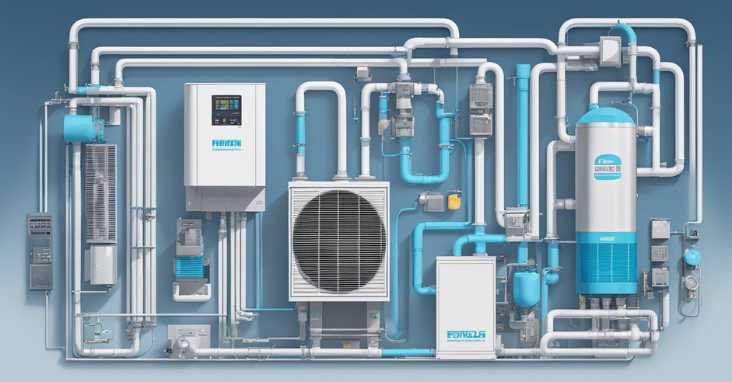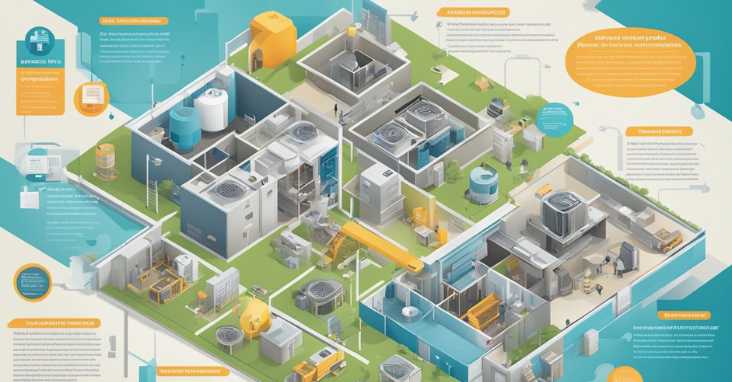What is HVAC marketing ? HVAC marketing promotes heating, ventilation, and air conditioning services to boost visibility and attract customers.
HVAC marketing is a critical aspect of any HVAC business. It involves developing strategies to promote HVAC products and services to potential customers. With the increasing competition in the industry, it is essential to have an effective marketing plan to stand out from the crowd.

Understanding HVAC marketing is crucial for any HVAC business owner. It involves identifying the target audience, creating a strong online presence, developing content marketing and SEO strategies, and improving customer engagement. A strong marketing plan can help HVAC businesses generate leads, increase brand awareness, and ultimately boost sales.
Key Takeaways
- Developing a strong online presence is crucial for HVAC businesses to stand out in a crowded market.
- Content marketing and SEO strategies are effective ways to drive traffic to an HVAC business’s website.
- Improving customer engagement can help HVAC businesses build brand loyalty and increase customer retention.
Understanding HVAC Marketing
The Importance of HVAC Marketing
In the HVAC industry, marketing plays a crucial role in attracting and retaining customers. HVAC marketing helps businesses to promote their services and build brand awareness. It also helps to differentiate their services from competitors and generate leads.
Effective HVAC marketing can help businesses to expand their customer base and increase revenue. It can also help to establish a positive reputation in the market. Therefore, it is important for HVAC businesses to have a well-planned marketing strategy that aligns with their business goals.
Key Components of HVAC Marketing
There are several key components of HVAC marketing that businesses should focus on:
Website Design and Optimization: A well-designed website that is optimized for search engines can help to attract more customers and generate leads. HVAC businesses should ensure that their website is mobile-friendly, easy to navigate, and provides relevant information to visitors.
Search Engine Optimization (SEO): SEO is the process of optimizing a website to rank higher in search engine results pages. HVAC businesses should focus on optimizing their website for relevant keywords and phrases to improve their visibility in search results.
Pay-Per-Click (PPC) Advertising: PPC advertising allows businesses to display ads on search engine results pages and other websites. HVAC businesses can use PPC advertising to target specific keywords and audiences to generate leads.
Social Media Marketing: Social media platforms such as Facebook, Twitter, and LinkedIn can be used to promote HVAC services and engage with customers. HVAC businesses should create a social media strategy that aligns with their business goals and target audience.
Email Marketing: Email marketing can be used to nurture leads and keep customers informed about new services and promotions. HVAC businesses should focus on creating targeted email campaigns that provide value to subscribers.
By focusing on these key components, HVAC businesses can create a comprehensive marketing strategy that helps them to achieve their business goals.
For more information on HVAC marketing, check out this guide from HVAC.com, a trusted resource in the HVAC industry.
Developing a Strong Online Presence
Creating a strong online presence is essential for any HVAC business that wants to succeed in today’s digital age. By building an effective website, leveraging SEO, and utilizing Google Business Profile, HVAC companies can increase their visibility and attract more customers.
Building an Effective HVAC Website
An HVAC website is the cornerstone of any online marketing strategy. A well-designed website should be easy to navigate, visually appealing, and provide valuable information to visitors. It should also be optimized for search engines to ensure that it ranks high in search results.
To build an effective HVAC website, businesses should focus on the following:
- Mobile responsiveness: With more and more people accessing the internet on their mobile devices, it’s essential to have a website that is mobile-friendly.
- Clear messaging: The website should clearly communicate what the business does and what services it offers.
- Calls to action: The website should have clear calls to action that encourage visitors to contact the business or schedule a service.
- Testimonials: Including customer testimonials on the website can help build trust and credibility.
Leveraging SEO for Higher Visibility
Search engine optimization (SEO) is the process of optimizing a website to rank higher in search engine results pages (SERPs). By leveraging SEO, HVAC businesses can increase their visibility and attract more customers.
To improve their SEO, businesses should focus on the following:
- Local SEO: HVAC businesses should focus on optimizing their website for local search queries. This includes optimizing their Google My Business profile, building local citations, and targeting local keywords.
- Keyword research: HVAC businesses should conduct keyword research to identify the keywords and phrases that their target audience is searching for.
- On-page optimization: On-page optimization involves optimizing the content and structure of a website to make it more appealing to search engines. This includes optimizing title tags, meta descriptions, and header tags.
- Link building: Building high-quality backlinks is an essential part of SEO. HVAC businesses should focus on building links from reputable sources in their industry.
Utilizing Google Business Profile
Google Business Profile is a free tool that allows HVAC businesses to manage their online presence across Google, including search and maps. By utilizing Google Business Profile, HVAC businesses can increase their visibility and attract more customers.
To optimize their Google Business Profile, businesses should focus on the following:
- Accurate information: The business name, address, and phone number (NAP) should be accurate and consistent across all online directories.
- Reviews: Encourage customers to leave reviews on the Google Business Profile. Positive reviews can help improve the business’s visibility and attract more customers.
- Photos: Including photos of the business, staff, and services can help make the Google Business Profile more appealing to potential customers.
By following these tips, HVAC marketing for businesses can develop a strong online presence and attract more customers. For more information on HVAC marketing, check out this article.
Content Marketing and SEO Strategies
Creating Valuable Content for HVAC Customers
Content marketing is a crucial aspect of any successful HVAC marketing strategy. By creating valuable content, HVAC companies can establish themselves as experts in their field and build trust with potential customers. When creating content for HVAC customers, it’s important to focus on their needs and pain points. This can include topics such as energy efficiency, indoor air quality, and maintenance tips.
One effective way to create valuable content is by addressing common questions and concerns that HVAC customers may have. This can be done through blog posts, videos, and social media content. By providing helpful information, HVAC companies can position themselves as a go-to resource for customers.
Optimizing for Search Engines
Search engine optimization (SEO) is the process of optimizing a website to rank higher in search engine results pages (SERPs). HVAC companies can use SEO strategies to increase their visibility online and attract more potential customers.
One important aspect of HVAC SEO is identifying relevant keywords and incorporating them into website content. This can include keywords related to HVAC services, such as “air conditioning repair” or “furnace installation.” HVAC companies can also use meta tags and meta descriptions to optimize their website for search engines.
Blogging for Brand Awareness
Blogging is a powerful tool for building brand awareness and driving traffic to a website. By regularly publishing blog posts, HVAC companies can establish themselves as thought leaders in their industry and attract potential customers.
When blogging for brand awareness, it’s important to focus on topics that are relevant to HVAC customers. This can include seasonal maintenance tips, energy-saving techniques, and product reviews. By providing valuable information, HVAC companies can build trust with potential customers and position themselves as experts in their field.
One external resource that can be helpful for HVAC companies looking to improve their content marketing and SEO strategies is the Moz blog. Moz is a leading authority on SEO and provides a wealth of information on topics such as keyword research, link building, and on-page optimization.
Overall, content marketing and SEO strategies are essential for HVAC companies looking to attract and retain customers. By creating valuable content, optimizing for search engines, and blogging for brand awareness, HVAC companies can establish themselves as experts in their field and build trust with potential customers.
Social Media and Online Advertising

Engaging with Customers on Social Media
Social media platforms such as Facebook, Instagram, and LinkedIn offer HVAC companies a great opportunity to connect and engage with their customers. By creating a strong social media presence, HVAC companies can showcase their services, products, and expertise, and build a loyal following of customers.
To effectively engage with customers on social media, HVAC companies should:
- Post regular updates and content that is relevant and valuable to their target audience.
- Respond promptly to customer inquiries and comments.
- Use social media analytics to track engagement and adjust their strategy accordingly.
- Encourage customers to leave reviews and ratings on their social media pages.
By following these strategies, HVAC companies can create a strong social media presence and build trust with their customers.
Effective Strategies for Social Media Advertising
Social media advertising is an effective way for HVAC companies to reach their target audience and drive traffic to their website. By using targeted advertising campaigns, HVAC companies can reach customers who are interested in their services and products.
To create effective social media advertising campaigns, HVAC companies should:
- Define their target audience and create ads that are tailored to their interests and needs.
- Use eye-catching visuals and compelling messaging to grab the attention of their target audience.
- Test and optimize their ads to improve their performance and ROI.
- Use retargeting to reach customers who have already shown interest in their services or products.
By following these strategies, HVAC companies can create effective social media advertising campaigns that drive results.
Exploring Pay-Per-Click Advertising
Pay-per-click (PPC) advertising, such as Google Ads and Local Services Ads, is another effective way for HVAC companies to reach their target audience and drive traffic to their website. PPC advertising allows HVAC companies to bid on keywords related to their services and products, and only pay when someone clicks on their ad.
To create effective PPC advertising campaigns, HVAC companies should:
- Conduct keyword research to identify the most relevant and profitable keywords for their business.
- Create compelling ad copy that highlights their unique selling proposition and encourages clicks.
- Use landing pages that are optimized for conversions and provide a seamless user experience.
- Track and analyze their campaigns to improve their performance and ROI.
By exploring PPC advertising, HVAC companies can reach their target audience and drive more leads and sales for their business.
For more information on social media and online advertising for HVAC companies, check out this resource.
Improving Customer Engagement

Customer engagement is a crucial aspect of HVAC marketing. It is important to keep customers engaged and satisfied to ensure they keep coming back for your services. Here are some effective ways to improve customer engagement:
Email Marketing Campaigns
Email marketing is an effective way to stay in touch with customers and keep them informed about your services. By sending newsletters, promotions, and updates, you can keep customers engaged and interested in your business. It is important to personalize the emails and make them relevant to the customer’s interests. According to Campaign Monitor, personalized emails have a 29% higher open rate and a 41% higher click-through rate than generic emails.
Leveraging Customer Reviews and Testimonials
Customer reviews and testimonials are a powerful tool for improving customer engagement. By showcasing positive reviews and testimonials on your website and social media platforms, you can build trust with potential customers and show them the quality of your services. It is important to respond to negative reviews in a professional and timely manner to show that you value customer feedback and are committed to providing excellent service.
Referral Programs and Customer Loyalty
Referral programs and customer loyalty programs are effective ways to improve customer engagement and build long-term relationships with customers. By offering incentives for referrals and loyalty, you can encourage customers to spread the word about your business and keep them coming back for your services. According to HubSpot, customers enrolled in loyalty programs spend 12-18% more per year than non-members.
In conclusion, improving customer engagement is crucial for HVAC marketing success. By utilizing email marketing campaigns, leveraging customer reviews and testimonials, and offering referral and loyalty programs, you can keep customers engaged, satisfied, and loyal to your business.
Local Marketing Techniques

As an HVAC business owner, targeting the local market is crucial for success. Local marketing techniques allow you to connect with potential customers in your area and increase brand awareness. In this section, we will cover some effective local marketing techniques and how to implement them.
Targeting the Local HVAC Market
To target the local HVAC market, it is important to identify your service area and target audience. This will help you create a marketing strategy that resonates with your potential customers.
One effective way to target the local market is by creating content that is specific to your service area. This can include blog posts, social media updates, and videos that showcase your expertise and knowledge of the local area.
Another effective way to target the local market is by using Google Local Services Ads. This advertising platform allows you to reach potential customers at the top of Google search results for HVAC-related searches in your area.
Optimizing for Local Search with NAP Consistency
To improve your local search rankings, it is important to have consistent NAP (Name, Address, Phone number) information across all online directories and platforms. This includes your website, Google My Business listing, and social media profiles.
Having consistent NAP information helps search engines understand that your business is legitimate and trustworthy. It also makes it easier for potential customers to find and contact your business.
Partnerships with Local Businesses
Partnering with local businesses can be a great way to increase brand awareness and reach potential customers. This can include collaborations with home builders, property managers, and other businesses that cater to your target audience.
One effective way to partner with local businesses is by offering referral incentives. This encourages other businesses to refer their customers to your business, which can lead to increased sales and brand recognition.
To learn more about local marketing techniques for HVAC businesses, check out this resource.
Analyzing and Optimizing Marketing Performance

Utilizing Data for Marketing Decisions
In today’s digital age, data is king. HVAC companies must leverage data to make informed marketing decisions. By analyzing data such as website traffic, social media engagement, and email open rates, companies can gain insights into what is working and what needs improvement. This data can help companies better understand their target audience and tailor their marketing efforts accordingly.
One useful tool for data analysis is Google Analytics. This free tool provides valuable insights into website traffic, including where visitors are coming from, which pages they are visiting, and how long they are staying on the site. By analyzing this data, HVAC marketing for companies can make informed decisions about which marketing channels to invest in and which to scale back on.
Measuring ROI and Conversion Rates
Measuring return on investment (ROI) and conversion rates is crucial for determining the success of marketing efforts. ROI measures the amount of revenue generated compared to the amount spent on marketing, while conversion rates measure the percentage of website visitors who take a desired action, such as filling out a contact form or making a purchase.
To track ROI and conversion rates, HVAC companies can use tools such as Google Ads and Facebook Ads Manager. These platforms allow companies to set specific goals and track the success of their campaigns in real-time. By analyzing this data, companies can adjust their marketing strategies to focus on what is working and eliminate what is not.
Adjusting the Marketing Plan for Better Results
Based on data analysis, HVAC companies should adjust their marketing plans to improve results. This may involve reallocating marketing budget to different channels, tweaking messaging to better resonate with the target audience, or experimenting with new marketing strategies.
To ensure success, it is important for companies to regularly review and adjust their marketing plans. By doing so, they can stay ahead of the competition and continue to grow their business.
For more information on analyzing and optimizing HVAC marketing performance, check out this helpful resource.
Design and Branding Elements

Creating a Recognizable Brand
Creating a recognizable brand is crucial for any HVAC marketing for businesses. A strong brand can help businesses stand out in a crowded market and attract more customers. A brand is more than just a logo or a name; it is the overall experience that a customer has with a business. This includes everything from the way a business communicates with its customers to the quality of its products and services.
To create a strong brand, HVAC businesses should start by defining their unique value proposition. This involves identifying what sets them apart from their competitors and what makes them the best choice for their target audience. Once this is established, businesses can develop a brand identity that reflects their values and personality.
Designing a Professional HVAC Marketing Logo
A professional HVAC marketing logo is an essential part of any branding strategy. A logo is the visual representation of a brand and should be designed to reflect the values and personality of the business. A well-designed logo can help businesses establish credibility and create a strong first impression with potential customers.
When designing an HVAC logo, it is important to consider the target audience and the message that the logo should convey. The logo should be simple, memorable, and easy to recognize. It should also be versatile enough to be used across different marketing channels, including social media, websites, and print materials.
The Role of User Experience in Website Design
In today’s digital age, having a website is essential for any HVAC business. A website is often the first point of contact that potential customers have with a business, so it is important to make a good first impression. User experience (UX) is a critical component of website design and can have a significant impact on how users perceive a business.
A website with good UX is easy to navigate, visually appealing, and provides users with the information they need quickly and efficiently. This includes having a responsive design that is mobile-friendly and optimized for different devices. A mobile-friendly website is especially important as more and more users are accessing the internet on their mobile devices.
To improve the UX of their website, HVAC marketing for businesses should focus on creating a clear and intuitive navigation structure, using high-quality images and videos, and optimizing their website for speed and performance.
For more information on HVAC marketing for website design and branding, check out this article.
Traditional Marketing and Advertising

Traditional marketing and advertising methods have been around for decades and are still effective today. They include methods such as print advertising, direct mail campaigns, and billboards. While digital marketing has become increasingly popular, it is important not to overlook the benefits of traditional methods.
Integrating Traditional and Digital Marketing
Integrating traditional and digital marketing can be a powerful way to reach a wider audience. By combining both methods, businesses can create a comprehensive marketing strategy that covers all bases. For example, a business can use traditional methods such as billboards to build brand awareness and direct mail campaigns to target a specific audience. They can then use digital marketing methods such as social media and email marketing to engage with their audience and drive conversions.
Using Direct Mail Campaigns Effectively
Direct mail campaigns are a form of traditional marketing that involves sending promotional materials directly to a target audience. This can include postcards, flyers, and brochures. When used effectively, direct mail campaigns can be a highly targeted and cost-effective way to reach potential customers.
To use direct mail campaigns effectively, businesses should ensure that their materials are well-designed, visually appealing, and include a clear call-to-action. They should also target their audience carefully and track the results of their campaigns to measure their effectiveness.
The Impact of Billboards and Physical Advertising
Billboards and physical advertising are forms of traditional marketing that can be highly effective in building brand awareness. They are particularly useful for businesses that operate locally or regionally. By placing billboards in high-traffic areas, businesses can reach a large audience and increase their visibility.
According to a study by the Outdoor Advertising Association of America, billboards are particularly effective at reaching younger audiences. They found that 58% of millennials have noticed a billboard in the past month, and 40% have visited an advertised restaurant or business as a result.
Overall, while digital marketing is important, businesses should not overlook the benefits of traditional marketing and advertising methods. By integrating both methods and using them effectively, businesses can create a comprehensive marketing strategy that reaches a wider audience and drives conversions.
Here is a Forbes article that discusses ways to integrate traditional and digital marketing.
Frequently Asked Questions

How can HVAC marketing for companies effectively utilize digital marketing?
HVAC marketing for companies can effectively utilize digital marketing by creating a strong online presence, targeting their ideal audience, and providing valuable content. This can be achieved through tactics such as search engine optimization (SEO), pay-per-click (PPC) advertising, email marketing, and social media marketing. By utilizing these strategies, HVAC companies can increase their visibility, build trust with potential customers, and ultimately drive more leads and sales.
What are some successful strategies for HVAC marketing for businesses?
Some successful marketing strategies for HVAC businesses include offering promotions and discounts, utilizing customer reviews and testimonials, and creating educational content. By offering promotions and discounts, HVAC marketing for businesses can attract new customers and incentivize existing ones to make repeat purchases. Customer reviews and testimonials can help build trust and credibility with potential customers, while educational content can position HVAC businesses as industry experts and thought leaders.
What role does social media play in marketing for HVAC services?
Social media can play a significant role in marketing for HVAC services by providing a platform for businesses to connect with their audience, share valuable content, and build brand awareness. By utilizing social media platforms such as Facebook, Twitter, and Instagram, HVAC businesses can engage with their followers, showcase their services, and promote special offers or promotions. Additionally, social media can be used to target specific demographics and reach a wider audience.
How important is SEO for an HVAC company’s online presence?
SEO is crucial for an HVAC company’s online presence as it helps improve their visibility and rankings in search engine results pages (SERPs). By optimizing their website and content for relevant keywords and phrases, HVAC companies can increase their chances of appearing at the top of search results when potential customers are searching for their services. This can lead to increased website traffic, higher conversion rates, and ultimately, more sales.
What are the latest trends in HVAC marketing for 2024?
Some of the latest trends in HVAC marketing for 2024 include the use of artificial intelligence (AI) and chatbots, personalized marketing, and video marketing. AI and chatbots can help automate customer service and provide quick and efficient responses to customer inquiries. Personalized marketing can help businesses tailor their messaging and offers to specific audiences, while video marketing can help showcase HVAC services and provide educational content in an engaging format.
How can an HVAC company measure the ROI of its marketing campaigns?
HVAC companies can measure the ROI of their marketing campaigns by tracking key metrics such as website traffic, lead generation, and conversion rates. By utilizing tools such as Google Analytics, HVAC companies can gain insights into the effectiveness of their marketing efforts and make data-driven decisions to optimize their campaigns. Additionally, implementing call tracking and lead attribution can help businesses accurately measure the impact of their marketing efforts on their bottom line.
For more information on HVAC marketing strategies, check out this guide from HVAC.com.





